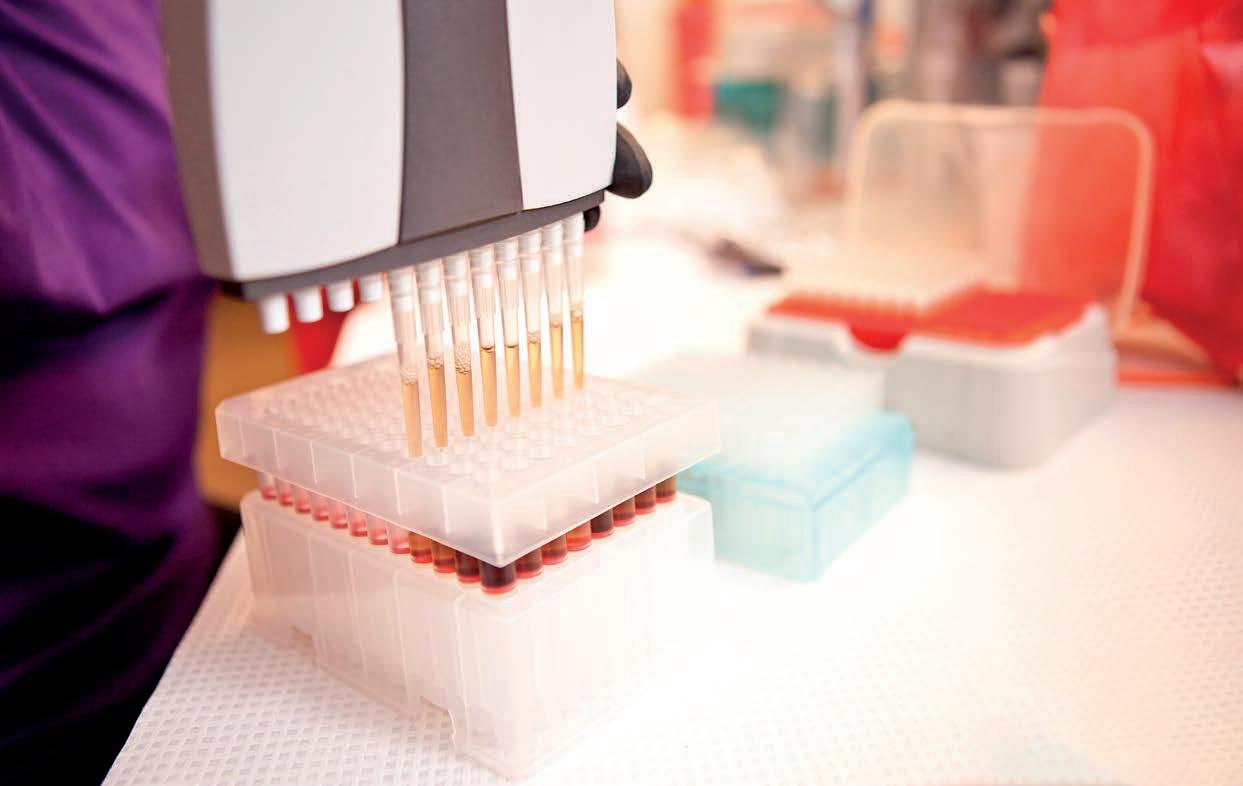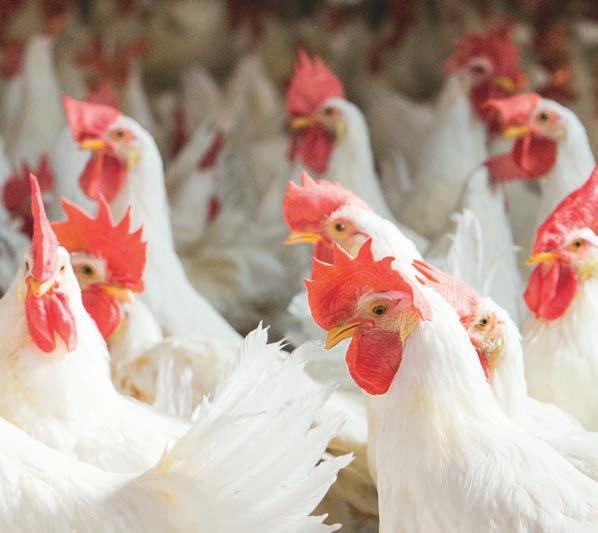
9 minute read
Protein nutrition of breeders to improve production, hatchability and offspring performance – First
In the last decades, poultry meat has become the most important protein source in human diet, and production is growing worldwide. Global poultry meat production in 2000 was 69 million tons and this increased to over 97 million tons in 2010. This equates to an annual production of approximately 70 billion broilers, originating from approximately 600 million broiler breeders.
Nowadays, management issues in broiler breeders associated with nutrition and reproductive characteristics are becoming increasingly challenging. Due to genetic selection on broilers, body composition of breeders has changed dramatically during the last 50 years to less fat and more breast muscle. It is postulated that a certain amount of body fat in broiler breeders at the onset of lay is necessary for maximum performance and offspring quality.
Advertisement
Body composition of breeders can be influenced by different feed allowances during rearing and lay, as well as by changes in nutrient composition of the diet. It can be concluded that feeding a low protein diet during rearing decreased breast muscle and increased abdominal fat pad. The higher abdominal fat pad content resulted in an increased hatchability during the first phase of lay and a larger number of eggs during the second phase of lay. On the other hand, a low daily protein intake during the rearing and first phase of lay can lead to a poor feather cover. Feeding a high-energy diet during the second phase of lay resulted in increased hatchability, decreased embryonic mortality and more first grade chicks.
Introduction
So a relatively small number of broiler breeders have a major impact on the poultry meat chain and optimizing management of breeders will have benefits for the total chain. Broiler breeders need to produce first class and healthy chicks. Due to the continuing increase in the genetic potential of the offspring, this is becoming increasingly challenging.
In the past, obesity, mainly in the second phase of the laying period, was a major problem in broiler breeder flocks and resulted often in a decreased reproduction rate during the laying period. Overweight hens have sperm storage problems (due to the fat deposition in the sperm storage glands) and physical problems during the cloacal contact during natural mating. The body composition of breeders, however, has changed dramatically during the last five to six decades. In modern broiler breeders, obesity is not an issue anymore, due to the selection of strains with increased breast muscle and decreased fat pad deposition characteristic. The selection for increased feed efficiency, growth rate and body fat content has not only affected the offspring but also the parent stock. This was recently confirmed by Eitan et al. (2014), who compared a 1980 to a 2000 breeder strain. The 2000 strain contained 42% more breast meat (21.2 vs. 14.9% of BW) and 50% smaller abdominal fat pad (2.7 vs. 5.4% of BW), compared to the 1980 strain.
Feeding high yield breeders high levels of amino acids (e.g. lysine) will lead to more muscle production and this extra muscle requires more energy to maintain. Therefore, during the last decade several researchers have reported that broiler breeders need a certain proportion of body fat at the onset of lay for subsequent reproductive performance. Because tissue growth is directly affected by dietary nutrient composition, a nutritional approach to this topic is highly relevant. Therefore, the overall practical objective of the present presentation is to give an overview of the research on the effect of protein intake during the rearing and laying period on body composition, breeder performance and offspring.
Effect of protein intake during rear on body composition
Changes in feed allowance or a change in diet composition (energy and/or protein levels) have been used as generally applied dietary interventions. Several authors have evaluated the use of a change in feed allowances on body composition during rearing or laying. Other studies evaluated the effects of a change in diet composition on body composition during rearing.
The combination of different feed allocations and different dietary protein levels in a single trial during the rearing period and its effects on body composition has received limited attention with the exception of a trial by Hocking et al. (2002). Such an experiment has been the focus of Van Emous et al. (2013), however, no interactions of the different feeding strategies on body composition were found. Moreover, differences in dietary protein levels during the rearing period were more effective than modifying the growth pattern by different feed allocations in changing body composition. This was probably due to the rather small differences (8%) in BW between treatments at the end of the rearing period as described in Van Emous et al. (2013). For example, Renema et al. (2001a) did not find an effect of an 11% higher BW, while a 21% higher BW increased abdominal fat content at the end of the rearing period. On the other hand, feeding broiler breeders to a 20% higher BW (2,640 vs. 2,200 g) at the end of rearing is relatively beyond practical conditions.
A, on average, 16% lower dietary CP during the rearing period in the studies reported by Van Emous et al. (2013, 2015a) resulted in a decreased breast meat and increased abdominal fat pad content at 10 wk of age and at onset of lay (20 and 22 wk of age). This was in close agreement with Mba et al. (2010) who found the same effects of a 12.5% reduction in crude protein content of the diet (14 vs. 16%) on body composition at 12 and 23 wk of age. In fact, not the dietary crude protein or amino acid content influenced body composition, but the differences in daily or total intake of the macro nutrients. On average, in both experiments of this thesis, the 16% lower protein diets (low vs. high protein diet) resulted in a 11% higher total energy, 5% lower total crude protein, and 7% lower total amino acid intake during the rearing period.
Average breast muscle (18.8 vs. 17.2%) and abdominal fat pad (1.0 vs. 0.4%) content at the end of the rearing period of all birds was relative higher in the study reported by Van Emous et al. (2015a) than the study by Van Emous et al. (2013). The differences between the experiments in breast muscle content might be explained by the differences in the higher total dietary protein and moreover total digestible lysine intake (+4.5%) in the second compared to the first experiment. Particularly dietary lysine is known as the major essential amino acid for breast muscle deposition in broilers and thus also for broiler breeders.
The abdominal fat pad content roughly doubled in the study reported by Van Emous et al. (2015a) compared to the study reported by Van Emous (2013) could be explained by two different factors. Firstly, body composition at the end of the rearing period was determined at 20 and 22 wk of age. In this pullet to breeder transition period, body composition or moreover fat content of the body changes dramatically. Secondly, the differences could be explained by the - on average - 4.5% higher cumulative energy intake in the study reported by Van Emous et al. (2015a).
At 15 wk of age, no effects of dietary protein level on abdominal fat pad (% BW) were found while this was present at wk 10. This phenomenon was also reported by Mba et al. (2010) who observed a difference in abdominal fat pad affected by differences in dietary protein level at wk 12 while this disappeared at 19 wk of age. It seems that abdominal fat pad and fat contents of the body follows a specific pattern during rearing with ageing. This pattern in body composition was previously reported by Bennet and Leeson (1990) who found a decreased total fat content between 2 and 14 wk of age but an increased fat content between 14 and 24 wk of age. Combining the data of different authors yields a quadratic relationship between age and abdominal fat pad content (% BW) during the rearing and pullet to breeder transition period (P<0.001).
The decreased abdominal fat pad weight around 12 wk of age is caused by the severe feed restriction levels (67 to 75%) between 7 and 16 wk of age, as described by De Jong and Guéméne (2011). It is likely that due to the severe feed restriction program during the midterm phase of rearing, pullets are required to use body (fat) reserves to meet energy requirements. This explains that the fat content of the body decreased during the severe feed restriction period while it increased again when energy intake increases substantially after 15 wk of age. Feathers are high in protein and amino acids, especially the sulfur-containing amino acids methionine and cysteine which are needed for the synthesis of feather keratin. Feather cover development is not well described in broiler breeder nutrition research. A low protein diet during the rearing period, however, had a negative effect on feather cover quality. In the experiment of Van Emous et al. (2013), feather cover was inferior on the low protein diet at 6 and 11 wk of age while this difference disappeared from 16 wk of age onward. In the experiment of Van Emous et al. (2015c), feather coverage was inferior on the low protein diet during the entire rearing period. It is, therefore, suggested that the protein and amino acid levels of the diets in the studies here were critical or deficient, in particular those amino acids needed for feather growth and development. The effect of daily protein intake on feather growth in broilers was previously reported by Twining et al. (1976), Aktara et al. (1996), Melo et al. (1999) and Urdaneta-Rincon and Leeson (2004).
The suggestion of protein deficiency was underlined by the malformed cover feathers on the wings in the current study what might be an indication of amino acids deficiency. Moran (1984) already showed that marginal dietary deficiencies of sulfur containing amino acids resulted in abnormal feathering. Data of Van Emous et al. (2013) were used to analyze the linear relationships between the total crude protein intakes at different phases during the rearing period on feather cover score. The data show that the effect of a low total CP intake on feather cover score was much more pronounced between 2 and 6 wk of age (P<0.001) than between 6 and 15 wk of age (P=0.182). It is therefore important to conclude that total CP (and AA) is a critical factor in development of feathers cover during rearing till approximately 6 wk of age.
A low daily protein intake during the first phase of the laying period resulted in a poor feather cover during the entire laying period. This phenomenon (low CP intake and poor feather cover) was observed during the rearing period as well. This effect was more pronounced in the first than in the second phase of lay, potentially because feather cover during the second phase was already almost completely damaged thereby masking treatment differences.
References available on request Source: 4 th International Poultry Meat Congress










